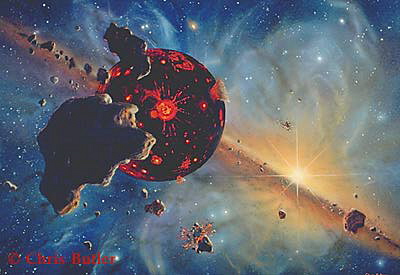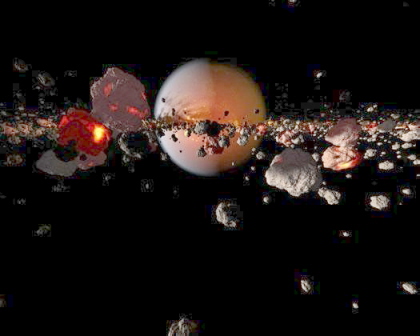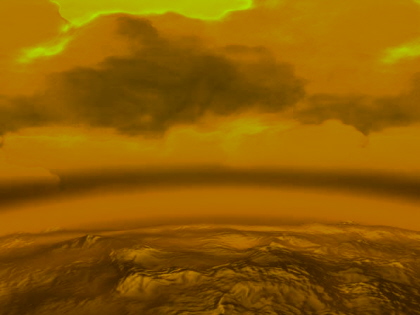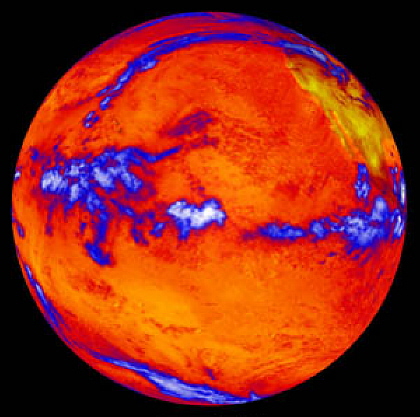Even earlier - forming Earth
We understand the past by employing a mental framework, but we don't all use the same framework. Conventional Science uses modern cosmology and the geological time scale. Old Earth Creationists do the same, but believe it was initiated by God. Young Earth Creationists use a short time scale derived from what they believe is the literal meaning of the biblical Book of Genesis, chapters 1 through 11. Young Biosphere Creationists use a recent time scale (thousands of years ago) for the creation of the biosphere, and an unknown time scale (likely billions of years) for the creation of the stars, planets, nebulas, etc. in the universe, including Earth, that is similar to conventional cosmology, with exceptions, and it was initiated by God. It is based on a detailed translation of particular Ancient Hebrew words in Genesis 1 and Exodus. I use the Young Biosphere Creationist framework for Earth's past and the Shock Dynamics geology theory.

It appears that the Earth formed (accreted) through a series of collisions with other growing objects (planetesimals) in the solar disk, a number of which had iron cores. Each collision added iron to the core and produced a "magma ocean" whose size depended on the size of the impactor and the size of the growing Earth. With each impact, water and heat-producing elements rose towards the surface. Eventually they became concentrated there. This left the Earth with a depleted mantle and an iron core. Modelling indicates that Earth accretion and core differentiation occurred simultaneously from roughly 20 major impacts over about 30 million years10.

However, each giant impact also flung some near-surface material away from Earth into space, and blew off a small amount of the growing atmosphere.

Earth retained much of its growing atmosphere during accretion, but most of the atmosphere formed near the end of accretion, being "degassed" catastrophically from the mantle. As long as the Earth was very hot, water at the surface became a thick steam atmosphere.

Once the Earth cooled sufficiently, the steam atmosphere collapsed to form an ocean of water on the surface.

The only substantial heat sources for the Earth are from the decay of radioactive elements and heat from the giant impacts of accretion. Because Earth's radioactive elements are concentrated near the surface, heat from this source is rapidly dissipated and does not accumulate. Yet the measured heat loss from the Earth is far greater than that produced by Earth's radioactive elements. To be specific, about 24 terawatts of heat are produced by radioactive elements in the Earth, while measured heat loss from the Earth is about 44 terawatts.16 Geophysicists speculate that there must be an insulated heat reservoir deep in the Earth releasing the rest of the measured heat over billions of years. However, it is more reasonable that the extra heat is primordial heat from the giant impacts of accretion, and that the Earth is much younger.
Once it has finished accreting, the cooling and solidifying of a rocky planet happens very quickly for the first 80%, lasting only a matter of 1000 years. Cooling and solidifying the final 20% lasts on the order of some millions of years, during which the crustal lid on top is separated from the crystallizing mantle below by a thin fluid layer. The Moon may have taken 10 million years to cool.5 The Earth is much larger than the Moon, and so might take longer to cool. But Earth still has a low-viscosity layer between the crust and upper mantle called the asthenosphere, indicating that Earth is in the latter stages of cooling.
______________________________________________________________________
SUPPORTING MATERIAL
ACCRETION
"Early differentiation of the Earth involved the separation of Fe-rich metal from silicate material to form the core and mantle. High temperatures were necessary and differentiation likely occurred in response to large-scale melting, induced by high-energy impacts that resulted in one or more deep magma oceans."14
Kinetic energy from these impacts caused the melting.4
"Earth's accretion history was dominated by tens of high-energy collisions with Moon- to Mars-sized bodies."14
"A series of magma oceans is likely if the crystallization time for the bulk of a deep magma ocean is short, i.e. on the order of 103 years."14
"Our model assumes Earth accretion and core differentiation occur simultaneously and the accretion history consists of a finite number of impacts distributed over 30 million years time, each impact large enough to create a regional or possibly global magma ocean." However, "The likelihood that the entire Earth was repeatedly liquified by impacts seems remote." "20 impacts were chosen because similar results were found in cases with more impacts."10
"The current dominant paradigm in mantle geochemistry is that the continental crust is complementary to the depleted mantle, which is the source of ocean floor basalt. However, attempts to mass-balance the continental crust with the depleted mantle assuming chondritic RLE ratios for the BSE show that the amount of depleted mantle that is complementary to the crust comprises only a fraction of the whole BSE... or approximately 50% from highly incompatible trace elements such as Rb. The remaining 70 to 50% is assumed to be primitive mantle, which has not had crust extracted from it, and should thus preserve chondritic proportions of RLEs, give rise to [chondritic] basalts... and contain a large fraction of the BSE's heat-producing elements (U, Th, and K). But it has become apparent that this paradigm is beset by several problems, one of the most obvious being that there is no empirical evidence from any rocks that primitive mantle exists, anywhere."12
"There is no single type of chondritic meteorite that would represent a suitable parental material for the Earth, neither with regard to chemistry nor isotopic composition."14
Towards the end of accretion, "geochemically enriched crust is preferentially lost" from large impacts.12
"During collisions of Moon- to Mars-sized bodies, large fractions of material may be lost. Present theories of planet formation consider neither the fate nor the composition of the 'lost' material."12
"The existence of magmatic iron meteorites, thought to be the cores of planetary embryos, of which specimens from as many as 70 different parent bodies are known, attests to the frequency with which silicate mantles were stripped from differentiated bodies in the early Solar System."12
Measuring the whole-Earth against the solar Fe/Mg ratio indicates "net collisional erosion of approximately 10% silicate relative to metal during the Earth's accretion. If this collisional erosion preferentially removed differentiated crust, the assumption of chondritic ratios among all refractory lithophile elements (RLEs) in the BSE would not be valid, with the BSE depleted in elements according to their geochemical incompatibility. In the extreme case, the Earth would only have half the chondritic abundances of the highly incompatible, heat-producing elements Th, U and K. Such an Earth model resolves several geochemical paradoxes: the depleted mantle occupies the whole mantle, is completely outgassed in 40Ar, and produces the observed 4He flux through the ocean basins. But the lower radiogenic heat production exacerbates the discrepancy with heat loss."12
"Refractory lithophile elements (RLEs) are defined as those that condense at higher temperatures than the common elements." For the Earth, "it has been an almost axiomatic assumption that the RLEs are present in the BSE in strictly chondritic ratios because these elements had not been observed to fractionate from each other in any type of chondrite". "The RLEs include Ca, Al, rare-earth elements (REEs), the radioactive heat-producing elements U and Th, and many others that are used in geochemical modeling." "The chondritic assumption has gone almost unchallenged for several reasons. Firstly, the assumption dates from well before our present understanding of planet building developed, in particular before the role of high-energy collisions during the later stages of the process was well appreciated." "Secondly, the pattern of chemical fractionations expected from preferential collisional erosion of early formed crust is just that which is expected anyway in the residues of crust formation. The process is therefore difficult to disentangle from the expected effects of the Earth's geological differentiation, except when the geochemical modeling involves summing over the whole planet." "Several strands of contrary evidence... are traditionally explained away by postulating never-sampled hidden reservoirs within the mantle."12
"Accretion of planets is an energetic affair that results in melting, degassing and differentiation rather than homogenization."2
A study finds "that for typical meteoritic volatile contents, degassing is likely to occur discontinuously, with an initial period of negligible degassing and a catastrophic degassing event later during the solidification process. The two key parameters controlling the degassing of magma oceans is the initial volatile content and the overall depth of the magma ocean."6
"Given that the hypothetical primitive mantle would be fertile, producing much more radiogenic heat than the depleted mantle, making it thermally buoyant, the lack of basalts from this hypothetical source is surely significant. The simple explanation is that the depleted mantle comprises the whole mantle, primitive mantle does not exist and the BSE has non-chondritic RLEs due to preferential collisional erosion during its accretion."12
HEAT
"Volatiles, including noble gases and heat producing elements, were sweated out of the materials that are now in the deep interior and concentrated into the outer shells."2
"The heat-producing elements K, Th, and U... would have been highly concentrated in the exterior shell of the early Earth."7
"There is little U, Th and K in the deep mantle. The concentration of heat production in the shallow mantle has not been allowed for in any model investigated by isotope geochemists or convection modelers".2
"The only viable heating today appears to stem from radioactive decay." If the Earth was actually over 4 billion years old, "there must be significant radioactive heating of the deep Earth" and very slow transport of this heat to the surface. That would "necessitate chemical stratification of the mantle. This situation must also have been sustained over the entire period during which this heat was stored in the deeper mantle, and hence throughout Earth history."7
"The BSE could be depleted by as much as 50% in U by preferential collisional erosion. The problem with such a low BSE abundance of UThK is, of course, the concomitant low radiogenic heat production in the mantle. The heat produced by 3 ppb UThK... is 3 TW, which is only a small fraction (approximately 10%) of the heat flow from the ocean basins of 31 TW." "It has led to models of a layered mantle separated by a boundary impermeable to 4He but not to heat, although how this might be accomplished is not apparent. An alternative explanation is simply that the BSE is not chondritic due to collisional erosion."12
"Radioactive decay of U and Th produces both heat and 4He." "There should be a simple relationship between the radiogenic heat and the 4He coming out of the mantle."12
"The inference from the 4He flux is that the present Earth's convecting mantle is thoroughly depleted from top to bottom."12
"There is no plausible mechanism for creating a uniform distribution of U, Th and K in the mantle, or for having the mantle cool uniformly or for retaining undegassed reservoirs."2
"In the uppermost parts of the mantle,... the amount of primordial heat that has been retained to the present-day is negligible."7
Once the mantle was depleted of heat-producing elements, it's "intrinsic heat production has probably been <10% of the average global heat production for most of Earth history, including the earliest Archean."7
"Concentration of the heat-producing elements K, Th, and U near the surface of the Earth considerably increases the efficiency of heat loss."7
"About twice as much heat is being lost from the Earth as is being generated today. This 'extra' heat lost today represents ancient heat produced and stored within the Earth."7
"Planets with magmas at the surface cool extremely quickly, even in the presence of an atmosphere."5
For magma oceans with depths ranging from 400 to 1500 km, cooling times are 40 to 165 years.15
"A cooling Martian magma ocean could have cooled through almost entirely to the solidus within thousands to several million years."13
"Heat loss from the Moon prior to formation of the conductive flotation lid is extremely rapid. Solidification of the first 80% by volume of the magma ocean... requires only on the order of 1000 years. As soon as a conductive lid is established on the body solidification slows greatly, and the remaining 20% by volume of the magma ocean requires about 10 million years to solidify in this reference model." "Thus, during the greatest majority of cooling, the Moon consists of a largely solid sphere with a solid conductive lid, and only a thin shell of liquid and crystals between."5
"The upper boundary layer of the mantle is fertile enough, hot enough, and variable enough to provide the observed range of temperatures and compositions of midplate magmas, plus it is conveniently located to easily supply these." "It is usually referred to as 'asthenosphere' and erroneously thought of as simply part of the well-mixed 'convecting mantle'." "Mantle potential temperature at depth under the central Pacific, and elsewhere, may be ~200 degrees C higher, without deep mantle plume input, than near spreading ridges."1
"Today there is an intrinsic temperature difference of 1000-2000 K across the D" layer separating the adiabatic portion of the lower mantle from the outer core." "The core now has a +1000 K of superheat (potential temperature relative to surface melting temperature), whereas the present day mantle has far less superheat. In other words, the present day thermal disequilibrium of the core and mantle is about as great as their chemical disequilibrium was during Earth formation, in spite of the fact that chemical diffusion is far slower than thermal diffusion. The present day superheat of the core could be a consequence of heat sources in the core. Possible heat sources for superheating the core after its formation include radioactive decay of 40K, ohmic and viscous heating. However, none of these is large enough to compensate for the secular cooling of the core over time. More plausibly, core superheat is a relic of the core formation process."10
WATER and ATMOSPHERE
"The origin of water on Earth is still puzzling. At one end of the models, the high temperature in the inner accretion disk hampered hydrous phases to exist so that external sources were needed, the so-called late veneer of comets, asteroids and/or meteorites suggested by lunar cratering. At the other end, Earth accreted hydrous silicate phases, or grains having adsorbed water from the solar nebula."9
Carbonaceous chondrite meteorites are thought to be made of the same material that forms rocky planets, such as Earth. Researchers "heated a variety of Carbonaceous Meteorite carbonaceous chondrite samples at carefully controlled rates to temperatures from 200 to 1200 degrees Celsius, and measured the partial pressures and relative abundances of the outgassed volatile species". They found that "for all the samples water has the highest abundance (~66%) followed by carbon monoxide (~17%) and carbon dioxide (~16%)."17 Early Earth was thus likely water-rich from its own components.
"Under reasonable assumptions, we find that no more than a few percent of Earth's water can be attributed to comets."9
"The larger the planet becomes, the less likely a given impact can melt the entire depth of the mantle (even the putative Moon-forming impact with the Earth may only have melted it to 2000 km depth)."4
"Almost all minerals that solidify from a bulk Earth magma composition are also denser than their coexisting magma. Solidification will therefore proceed from the bottom upward, with increasingly evolved magmas lying above growing layers of solid silicate minerals." "Because water and carbon are only minimally incorporated in these minerals, the magma is increasingly enriched in water and carbon compounds as solidification proceeds."4
Each impact continues the process of degassing and moving magma ocean liquids toward the planetary surface. "These impacts might be expected to blow off about half of the surface volatiles."4
"Late-stage magma ocean liquids will eventually become so enriched with water as to be... super-critical water oceans." It "is then effectively a hot water ocean."4
"A planetary atmosphere will not likely grow gradually, but will degas catastrophically toward the end of solidification".4
Most volatile elements in a planet are "degassed into the atmosphere during the end of magma ocean solidification, leaving only a small fraction of the original volatiles to be released into the atmosphere through later volcanism. Rocky planets that accrete with water in their bulk mantle have two mechanisms for producing an early water ocean: First, if they accrete with at least 1 to 3% by mass of water in their bulk composition, liquid water may be extruded onto the planetary surface at the end of magma ocean solidification. Second, at initial water contents as low as 0.01% by mass or lower, during solidification a massive supercritical fluid and steam atmosphere is produced that collapses into a water ocean upon cooling." For Earth, "the more probable source for early water oceans is the collapse of the planet's steam atmosphere."4
Considering planets with masses roughly similar to Earth, "if these planets began with 0.1% by mass water, the global ocean resulting from atmospheric collapse would be 1 to 10 kilometers deep, and beginning with 0.5% by mass water results in global water oceans tens of kilometers deep."4
"3% by mass is the maximum water content found in meteorites from differentiated parent bodies, and is therefore a maximum likely initial water content for any terrestrial planet in our solar system."4
A planet with Earth's mass and 1 to 3% by mass water in the mantle would produce a massive atmosphere.4
"Between 60 and 90% by mass of the original water in the planetary magma ocean is degassed into the growing atmosphere". "Even very small initial water contents, therefore, can produce substantial steam atmospheres."4
"When the surface temperature cools below the critical point (approximately 647 K [705.2 F] and 220 bars) the supercritical fluid and steam atmosphere will collapse into a surface ocean."4
"Within tens of millions of years of the initiation of a magma ocean the planetary mantle will be solid and compositionally stable, and the planet's surface temperature will have passed the critical point of water and cooled into the liquid water stability field."4
ATMOSPHERIC LOSS?
"When a giant impact occurs, atmosphere loss may occur due to global ground motion excited by a strong shock wave traveling in the planetary interior."8
"The estimated loss fraction for the giant impact is only 20%. Significant escape occurs only when the ground velocity is close to the escape velocity. Thus, most of the atmosphere should survive the giant impact."8
A small planet with an atmosphere can impact a larger planet. "A significant fraction of the impactor's atmosphere survives and is brought to the target planet."8
MOON
"The Moon itself is an example of the product of a collisional erosion event involving the Earth during the final stages of its accretion. The mass of the Moon is 1.8% of the mass of the Earth's mantle."12
"The Moon is believed to have formed largely from impactor material following the collision between the Earth and Theia."14
"Magma oceans of as much as 1000 km depth are consistent with creating an anorthositic crust 40 to 50 km in thickness" in the case of the Moon.5
In contrast to the Earth, the Moon lacks a large iron core.3
"In order to produce 13.6% by weight FeO in the Moon's mantle, approximately 70% of the Moon would have to be derived from Theia. This value is very similar to the results derived from numerical simulations of the Moon-forming impact."14
"The most favorable conditions for producing a sufficiently massive and iron-depleted protolunar disk involve collisions with an impact angle near 45 degrees and an impactor velocity at... < 4 km/sec. For a total mass and angular momentum near to that of the current Earth-Moon system, such impacts typically place about a lunar mass of material into orbits exterior to the Roche limit, with the orbiting material composed of 10 to 30% by mass vapor. In all cases, the vast majority of the orbiting material originates from the impactor."3
"The impactor material that ends up in orbit is primarily that portion of the object that was heated the least, having avoided direct collision with the Earth."3
Among likely scenarios, "those that leave the Earth > 95% accreted after the Moon-forming impact are favored here, implying a giant impactor mass between 0.11 and 0.14 Earth masses."3
"The simplest explanation for the Moon's unusual compositional characteristics is that it is the result of an impact that occurred near the very end of terrestrial accretion."3
Portions of the Moon's crust are strongly magnetized, but the origin of the fields that magnetized the crust is uncertain. One proposed solution is that "dynamo action comes from impact-induced changes in the Moon's rotation rate. Basin forming impact events are energetic enough to have unlocked the Moon from synchronous rotation, and we demonstrate that the subsequent large-scale fluid flows in the core, excited by the tidal distortion of the core-mantle boundary, could have powered a lunar dynamo. Predicted surface magnetic field strengths are on the order of several microteslas, consistent with palaeomagnetic measurements, and the duration of these fields is sufficient to explain the central magnetic anomalies associated with several large impact basins."11
**********
1. Anderson, Don L. 2010. Hawaii, Boundary Layers and Ambient Mantle - The LLAMA Model (Invited). American Geophysical Union, Fall Meeting, abstract #T12A-02.
2. Anderson, Don L. 2008. Where are U and He? American Geophysical Union, Fall Meeting, abstract #T21C-1982.
3. Canup, Robin M. 2004. Simulations of a late lunar-forming impact. Icarus, Vol. 168, pp. 433-456.
4. Elkins-Tanton, Linda T. 2011. Formation of early water oceans on rocky planets. Astrophysics and Space Science, Vol. 332, pp. 359-364.
5. Elkins-Tanton, Linda T., Seth Burgess, Qing-Zhu Yin. 2011. The lunar magma ocean: Reconciling the solidification process with lunar petrology and geochronology. Earth and Planetary Science Letters, Vol. 304, pp. 326-336.
6. Elkins-Tanton, Linda T., J. Suckale. 2010. The Possibility of Catastrophic Magma Ocean Degassing and Implications for the Formation of Early Planetary Atmospheres. American Astronomical Society, DPS meeting #42, #52.05; Bulletin of the American Astronomical Society, Vol. 42, p. 1071.
7. Galer, S.J.G., S.L. Goldstein. 1991. Early mantle differentiation and its thermal consequences. Geochimica et Cosmochimica Acta, Vol. 55, pp. 227-239.
8. Genda, Hidenori, Yutaka Abe. 2003. Survival of a proto-atmosphere through the stage of giant impacts: the mechanical aspects. Icarus, Vol. 164, pp. 149-162.
9. Hutsemekers, Damien, Jean Manfroid, Emmanuel Jehin, Claude Arpigny. 2009. New constraints on the delivery of cometary water and nitrogen to Earth from the 15N/14N isotopic ratio. Icarus, Vol. 204, pp. 346-348.
10. King, Christina, Peter Olson. 2011. Heat partitioning in metal-silicate plumes during Earth differentiation. Earth and Planetary Science Letters, Vol. 304, pp. 577-586.
11. Le Bars, M., M. A. Wieczorek, O. Karatekin, D. Cebron, M. Laneuville. 10 November 2011. An impact-driven dynamo for the early Moon. Nature, Vol. 479, pp. 215-218.
12. O'Neill, Hugh St.C., Herbert Palme. 2008. Collisional erosion and the non-chondritic composition of the terrestrial planets. Philosophical Transactions of the Royal Society A, Vol. 366, pp. 4205-4238.
13. Righter, Kevin, Nancy L. Chabot. 2011. Moderately and slightly siderophile element constraints on the depth and extent of melting in early Mars. Meteoritics & Planetary Science, Vol. 46, Nr. 2, pp. 157-176.
14. Rubie, David C., Daniel J. Frost, Ute Mann, Yuki Asahara, Francis Nimmo, Kyusei Tsuno, Philip Kegler, Astrid Holzheid, Herbert Palme. 2011. Heterogeneous accretion, composition and core-mantle differentiation of the Earth. Earth and Planetary Science Letters, Vol. 301, pp. 31-42.
15. Rubie, D.C., H.J. Melosh, J.E. Reid, C. Liebske, K. Righter. 2003. Mechanisms of metal-silicate equilibration in the terrestrial magma ocean. Earth and Planetary Science Letters, Vol. 205, pp. 239-255.
16. The KamLAND Collaboration (66 authors). September 2011. Partial radiogenic heat model for Earth revealed by geoneutrino measurements. Nature Geoscience, Vol. 4, pp. 647-651.
17. Thompson, Maggie A., Myriam Telus, Laura Schaefer, Jonathan J. Fortney, Toyanath Joshi, David Lederman. 2020. Meteorite outgassing experiments and their constraints on modeling the initial atmospheres of low-mass planets. 51st Lunar and Planetary Science Conference, Abstract 1205.pdf.
John Michael Fischer, 2011-2026
www.newgeology.us